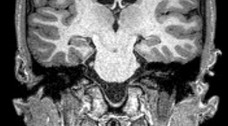Size may not matter as much as we thought
2015-05-13

New work by the Douglas Mental Health University Institute (CIUSSS de l’Ouest-de-l’île-de-MontréalI) computational neuroscientist Mallar Chakravarty, PhD, and in collaboration with researchers at the Centre for Addiction and Mental Health (CAMH) challenges in a thrilling way the long-held belief that a larger hippocampus is directly linked to improved memory function.
The size of the hippocampus, an important structure in the brain's memory circuit, is typically measured as one method to determine the integrity of the memory circuit. However, the shape of this structure is often neglected. Using a novel algorithmic technique to map the hippocampus, Dr. Chakravarty, Assistant Professor, Department of Psychiatry at McGill University, is shedding new light on its shape. The algorithm developed by the team identifies individuals with differently shaped hippocampi. In fact, the study has found that while stereotypic shapes exist for this structure, individuals with a broad-shaped hippocampus tend to perform better on various tests that assess memory. In the study, these shape differences were better predictors of memory function than the bulk volume of the hippocampus.
“This exciting new finding may help us improve our understanding of how to preserve the memory circuit and its function. This work shows the value of multidisciplinary research, as it required the close collaboration of engineers, computer scientists and psychiatrists to complete this work,” says Dr. Chakravarty, senior author on the study. Chakravarty’s student Julie Winterburn notably worked on this project, and was co-first author with Dr. Aristotle Voineskos of CAMH’s Campbell Family Mental Health Research Institute. in Toronto.
Why it matters
Improving our understanding of the geometry of different structures may have significant implications in understanding neuropsychiatric disorders, such as Alzheimer's disease, where memory function is significantly compromised. Given the aging demographics of Quebec and Canada, uncovering clues on how to improve memory function, one of the main impairments reported (even in healthy aging), will be critical to relieving the overwhelming burden our health care system currently faces. The results of this recent research are published in Human Brain Mapping, a peer-reviewed scientific journal.
Funding
Dr. Chakravarty’s work is funded by the Canadian Institutes for Health Research, Natural Sciences and Engineering Research Council, Weston Brain Institute, Alzheimer’s Society, and the Michael J. Fox Foundation for Parkinson’s Research.
About Mallar Chakravarty
Mallar Chakravarty leads the Computational Brain Anatomy (CoBrA) Laboratory at the Brain Imaging Centre. His group is a dynamic multi-disciplinary laboratory that is interested the anatomy of the brain and more specifically:
• how it matures through adolescence
• how it stays healthy through the normal aging process
• how alterations in brain anatomy are related to neurodegenerative disorders such as Alzheimer's and Parkinson's disease and neurodevelopmental disorders such as schizophrenia.
Information or interviews
Florence Meney
Media Relations
Communications and Public Affairs
Douglas Mental Health University Institute
Tel.: 514-761-6131, ext. 2769
florence_dot_meney_At_douglas_dot_mcgill_dot_ca


